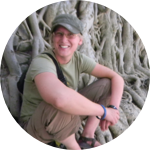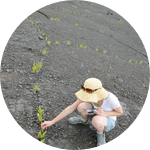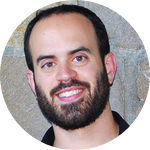About This Project
Animal social groups are much more than the sum of their parts. Consider birds flying together in formation, or fish evading a predator. These emergent collective behaviors are thought to arise from individuals following simple computational "rules". This research aims to apply such computational algorithms and dynamic network analysis to social organization and behavior of geladas--a primate that lives in a complex modular society.Ask the Scientists
Join The DiscussionWhat is the context of this research?
In the mountains of Ethiopia, the world's only grass-eating primate lives. The gelada is a monkey unlike most of its relatives. Geladas are cousins of common baboons, but are unique in their social structure and ecology. Whereas most primates species live in small groups (10-50 individuals) within tropical forests, geladas graze in herds of over 1000 individuals on the grassy plateaus of the Ethiopian highlands. They are quite literally the cows of the monkey world.
Within these large herds of monkeys, smaller permanent subgroups of related females (core groups) live and forage together. These groups may split off and rejoin one another creating new herds that may last for a few hours or several days. Because geladas live in such large and complex societies, it is not known how they make decisions about where to go and who to follow when forming herds. Moreover, we do not know why some herds persist for days while others split up rapidly.
My research aims to understand the social and ecological factors that bind gelada herds together. I will use newly-developed computational methods to answer the following questions:
1. Which individuals are most influential in leading herd movement?
2. To what degree do social relationships mediate movement decisions within a gelada herd?
3. How do ecological factors, like food availability, interact with social factors to produce group-level behavior?
What is the significance of this project?
This project will be one of the first studies to employ dynamic network algorithms to understand primate social organization and behavior. Through using dynamic networks, my research will transform how biologists understand the adaptive value of association in changing environments. Potential findings will be of great interest to computer scientists and behavioral ecologists interested in the evolution of cooperation, coordination, and complex systems.
My research will help conserve the Afroalpine habitat of the Simiens Mountains National Park (SMNP), Ethiopia. The park is a World Heritage Site “In Danger” (1996). While in Ethiopia, I will give public talks on conserving Ethiopian biodiversity at a local ecotourism lodge and train Ethiopian nationals as field assistants. Upon returning to the U.S., I anticipate giving talks to high school biology students.
What are the goals of the project?
To complete this research, I will use a combination of GPS technology, on-the-ground behavioral and ecological data, and satellite imagery. In Ethiopia, I am associated with the University of Michigan Gelada Research Project (UMGRP). Scientists of the UMGRP have been studying a population of wild geladas living in the Simien Mountains for nearly 7 years. Previously, I lived in this remote location for 2 years during my dissertation research. My project has three primary goals.
1. Collect behavioral and movement data of gelada groups using handheld GPS units. The gelada study subjects are fully-habituated to observers on foot.
2. Analyze data using dynamic network algorithms and build models of modular social organization.
3. Educate public on gelada behavioral ecology and conservation through public talks and outreach within the Simien Mountains National Park.
Budget
The main expenses for this project are an international flight from the U.S. to Ethiopia (1800 USD), GPS units, and the research permit (1000 USD). My research permit is good for an entire year and will allow me to make additional trips to Ethiopia to collect more data. I have a stretch goal of 5000 USD that will allow me to pay additional field assistants, buy more GPS units, and stay longer in Ethiopia.
Endorsed by
Meet the Team
Team Bio
I am a biologist interested in the evolution of cooperation, coordination, and social complexity among primates. I lived in the mountains of Ethiopia for nearly 2 years while studying geladas for my dissertation research (University of Michigan, 2013). Before graduate school, I was a high school biology teacher. I continue to work with high school educators to develop lessons on primate evolution and ecology.Although I am the principle investigator of this project, I work with many collaborators across several institutions. My primary association is with the Department of Ecology and Evolutionary Biology at Princeton University, but I also work with computer scientists at the University of Illinois-Chicago and my former research group at the University of Michigan. If you'd like to know more about me, my research, or geladas, please send me a tweet (@djpappano) or visit my webpage.
David Pappano, Ph.D.
I'm a biologist interested in the evolution of social complexity, particularly among primates. I lived in the mountains of Ethiopia for nearly 2 years while studying geladas for my dissertation research (Ph.D. University of Michigan, 2013). Before graduate school, I was a high school biology teacher. If you'd like to know more about me, my research, or geladas, please send me a tweet (@djpappano) or visit my website.
Press and Media
PHOTOSA male gelada overlooks a cliff.
http://imgur.com/TJ5jusZ A male human (me) overlooks a cliff.
http://imgur.com/baCeZl2
Female geladas grooming each other.
http://imgur.com/EFIyzb2
OUTREACH
Here is a press release from my presentation at a Youth Conference in Addis Ababa, Ethioipia
http://ethiopia.usembassy.gov/pr_043011.html
Here is another from a talk I gave to high school students in the U.S.
http://www.delbarton.org/news/detail.aspx?pageacti...
Additional Information
REWARDSAs a backer of this project, you will receive updates through my Lab Notes. You can keep track of my daily research activities here at my Open Lab Notebook. You can also follow me on Twitter @djpappano for more pictures and videos from my field research in Ethiopia.
All individuals who donate more than 100 USD to my project will receive an acknowledgement and copies of all publications derived from my research.
PUBLICATIONS
Here is a link to all the publications from our research group:
UM Gelada Research Project
Project Backers
- 7Backers
- 7%Funded
- $215Total Donations
- $30.71Average Donation



